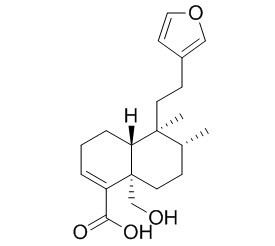Hautriwaic acid
Hautriwaic acid shows anti-inflammatory activity in 12-O-tetradecanoylphorbol 13-acetate (TPA) mice ear edema models, it diminishes the joint edema induced by this mixture of polysaccharides (carrageenan), possibly by acting as immunomodulator of the inflammatory response. Hautriwaic acid present in the methanolic extract and its ethyl acetate, and aqueous fractions may be responsible for this hepatoprotective activity of Dodonaea viscosa which was confirmed by in vivo experiments.
Inquire / Order:
manager@chemfaces.com
Technical Inquiries:
service@chemfaces.com
Tel:
+86-27-84237783
Fax:
+86-27-84254680
Address:
1 Building, No. 83, CheCheng Rd., Wuhan Economic and Technological Development Zone, Wuhan, Hubei 430056, PRC
Providing storage is as stated on the product vial and the vial is kept tightly sealed, the product can be stored for up to
24 months(2-8C).
Wherever possible, you should prepare and use solutions on the same day. However, if you need to make up stock solutions in advance, we recommend that you store the solution as aliquots in tightly sealed vials at -20C. Generally, these will be useable for up to two weeks. Before use, and prior to opening the vial we recommend that you allow your product to equilibrate to room temperature for at least 1 hour.
Need more advice on solubility, usage and handling? Please email to: service@chemfaces.com
The packaging of the product may have turned upside down during transportation, resulting in the natural compounds adhering to the neck or cap of the vial. take the vial out of its packaging and gently shake to let the compounds fall to the bottom of the vial. for liquid products, centrifuge at 200-500 RPM to gather the liquid at the bottom of the vial. try to avoid loss or contamination during handling.
Universiti Tunku Aboul Rahman2023, 6263.
Front Pharmacol.2022, 13:883475.
Pharmaceuticals (Basel).2021, 14(10):1046.
BioResources J.2020, 15(3).
Int Immunopharmacol.2023, 7:127:111322.
Food Control2022, 132:108434.
Food and Bioprocess Technology2017, 10(6):1074-1092
Cell Signal.2022, 99:110433.
Herbal Formula Science2024, 32(3):203-221
J Chromatogr B Analyt Technol Biomed Life Sci.2019, 1124:323-330
Related and Featured Products
Planta Med. 2015 Sep;81(14):1240-7.
Effect of Hautriwaic Acid Isolated from Dodonaea viscosa in a Model of Kaolin/Carrageenan-Induced Monoarthritis.[Pubmed:
26166136]
In the present work, the antiarthritic activity of Hautriwaic acid is reported.
METHODS AND RESULTS:
This ent-clerodane diterpene isolated from Dodonaea viscosa was evaluated in mice using a kaolin/carrageenan-induced monoarthritis model. The inflammation observed in the joint (knee) on days 1-8 ranged from 50-70 %. After 10 days of treatment with different doses of Hautriwaic acid (5, 10, 20 mg/kg), a decrease in knee inflammation was detected. This recovery was observed with both reference drugs, methotrexate (1 mg/kg) and diclofenac (0.75 mg/kg). In these groups of mice, the concentration of proinflammatory cytokines interleukin-1 beta, interleukin-6, and tumor necrosis factor alpha in the joint was significantly lower than that of the negative control group (animals with damage without any treatment). The negative control group presented a decrease in the concentration of interleukin-10, while the groups that received Hautriwaic acid at different dose exhibited an increase in this interleukin.
CONCLUSIONS:
This anti-inflammatory cytokine was not modified in the joint of mice with diclofenac, but in mice that received methotrexate, a significant decrease was observed. Hautriwaic acid isolated from D. viscosa diminished the joint edema induced by this mixture of polysaccharides (carrageenan), possibly by acting as immunomodulator of the inflammatory response.
Molecules. 2012 Apr 10;17(4):4292-9.
Anti-inflammatory activity of hautriwaic acid isolated from Dodonaea viscosa leaves.[Pubmed:
22491678]
The aim of this study was to identify an anti-inflammatory compound from D. viscosa leaves.
METHODS AND RESULTS:
The structure of this bioactive substance was elucidated by IR and NMR studies, which indicated that this natural product corresponds to Hautriwaic acid (HA). This diterpene exhibited good anti-inflammatory activity in 12-O-tetradecanoylphorbol 13-acetate (TPA) mice ear edema models by applications at doses of 0.25, 0.5 and 1.0 mg/ear (60.2, 70.2 and 87.1% inhibition, respectively); additionally Dodonaea viscosa dichloro-methane extract (DvDE) displays a 97.8% anti-inflammatory effect at 3 mg/kg. Multiple applications of DvDE at doses of 100 mg/kg on TPA mice ear edema inhibited the edema-associated inflammation by 71.8%, while HA at doses of 15 mg/kg, reduced edema to 64% and indomethacin 40%.
Phytomedicine. 2014 Jan 15;21(2):131-40.
Hautriwaic acid as one of the hepatoprotective constituent of Dodonaea viscosa.[Pubmed:
24075215]
It is widely known that hepatitis and its complications such as cirrhosis or hepatocellular carcinoma are one of the major health problems of the world especially since no specific treatment is available.
METHODS AND RESULTS:
In the present study we investigated the hepatoprotective potential of the methanolic extract of the whole plant of Dodonaea viscosa and its ethyl acetate, aqueous, butanol and n-hexane fractions against carbon tetrachloride (CCl₄) induced hepatoxicity in rats. Hepatoprotection was assessed in terms of reduction in serum enzymes (ALT, AST, and ALP) that occur after CCl₄ injury, and by histopathology and immunohistochemistry. The methanolic extract reduced the serum enzyme level (ALT, AST, and ALP) down to control levels despite CCl₄ treatment. It also reduced the CCl₄-induced damaged area to 0% as assessed by histopathology. The CD68+ macrophages were also reduced in number around the central vein area by the methanolic extract. These hepatoprotective effects were better than the positive control silymarin.
Similar hepatoprotective activities were found with the ethyl acetate, and aqueous fractions of the methanolic extract. The butanol and n-hexane fractions showed elevated levels of ALT, AST and ALP as compared to the positive control silymarin. Histopathology showed ∼30% damage to the liver cells with the butanol and n-hexane fractions which still showed some protective activity compared to the CCl₄ treated control.
CONCLUSIONS:
HPLC fingerprinting suggested that Hautriwaic acid present in the methanolic extract and its ethyl acetate, and aqueous fractions may be responsible for this hepatoprotective activity of Dodonaea viscosa which was confirmed by in vivo experiments.



